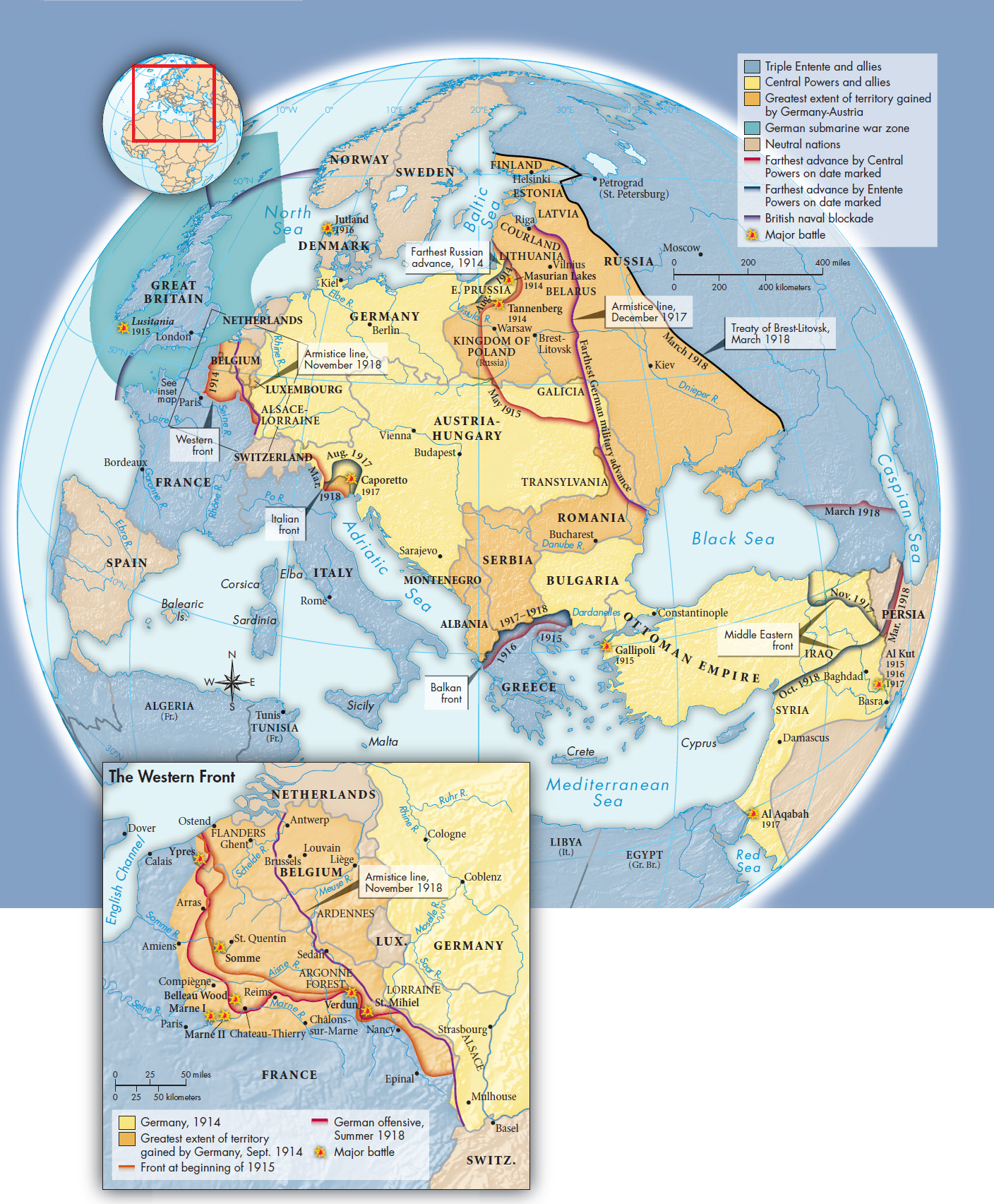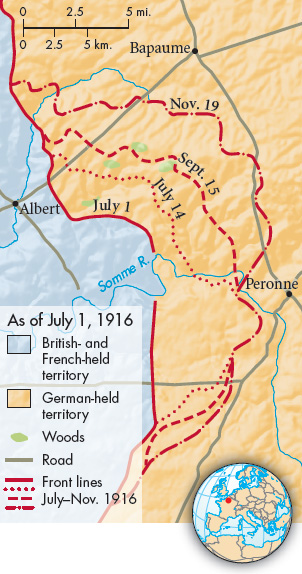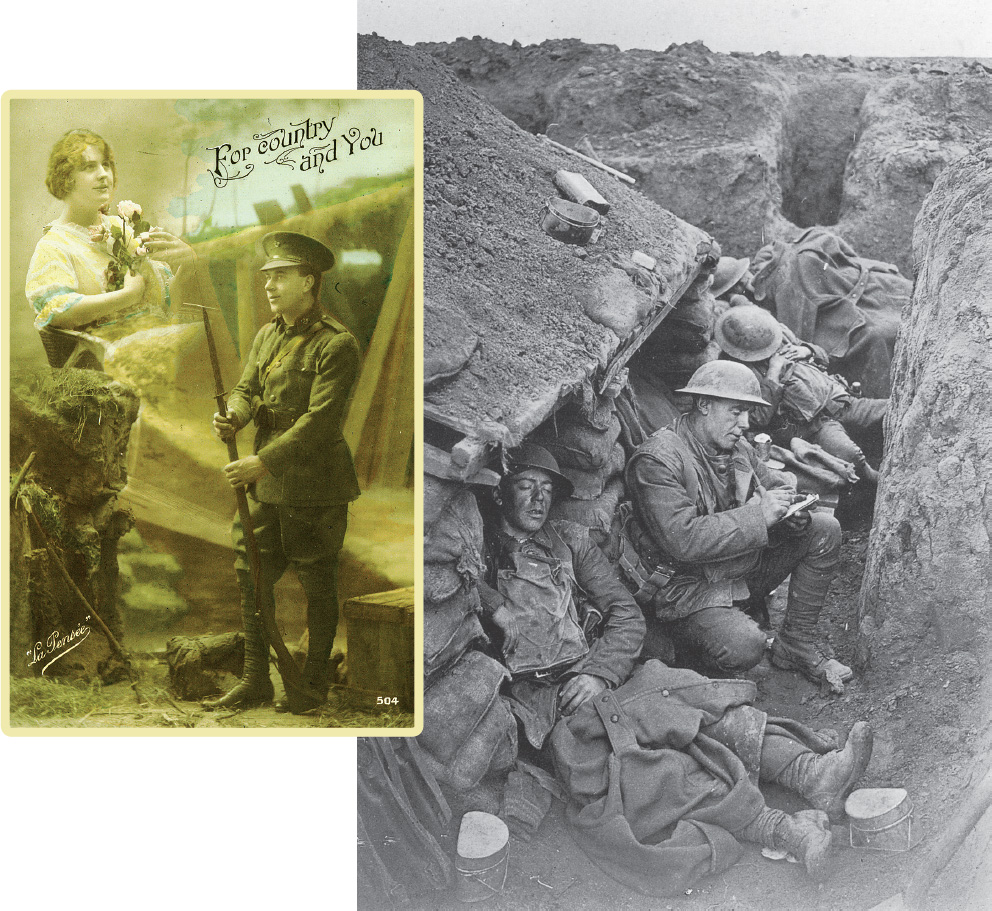A History of Western Society: Printed Page 830
A History of Western Society, Value Edition: Printed Page 839
Stalemate and Slaughter on the Western Front
In the face of the German invasion, the Belgian army heroically defended its homeland and fell back in good order to join a rapidly landed British army corps near the Franco-Belgian border. At the same time, Russian armies attacked eastern Germany, forcing the Germans to transfer much-needed troops to the east. Instead of quickly capturing Paris per the Schlieffen Plan, by the end of August dead-tired German soldiers were advancing slowly along an enormous front in the scorching summer heat.
On September 6 the French attacked a gap in the German line at the Battle of the Marne. For three days, France threw everything into the attack. At one point, the French government desperately requisitioned all the taxis of Paris to rush reserves to the front. Finally, the Germans fell back. France had been miraculously saved (Map 25.3).

With the armies stalled, both sides began to dig trenches to protect themselves from machine-gun fire. By November 1914 an unbroken line of four hundred miles of defensive trenches extended from the Belgian coast through northern France and on to the Swiss frontier. Armies on both sides dug in behind rows of trenches, mines, and barbed wire defenses, and slaughter on the western front began in earnest. The cost in lives of trench warfare was staggering, the gains in territory minuscule. For ordinary soldiers, conditions in the trenches were atrocious. (See “Living in the Past: Life and Death on the Western Front.”) Recently invented weapons, the products of an industrial age, made battle impersonal, traumatic, and extremely deadly. The machine gun, hand grenades, poison gas, flamethrowers, long-range artillery, the airplane, and the tank were all used to murderous effect. All favored the defense, increased casualty rates, and revolutionized the practice of war.

The leading generals of the combatant nations, who had learned military tactics and strategy in the nineteenth century, struggled to understand trench warfare. For four years they repeated the same mistakes, mounting massive offensives designed to achieve decisive breakthroughs. Brutal frontal assaults against highly fortified trenches might overrun the enemy’s frontline, but attacking soldiers rarely captured any substantial territory. The French and British offensives of 1915 never gained more than three miles of territory. In 1916 the unsuccessful German campaign against Verdun cost some 700,000 lives on both sides and ended with the combatants in their original positions. The results in 1917 were little better. In hard-fought battles on all fronts, millions of young men were wounded or died for no real gain.
The Battle of the Somme, a great British offensive undertaken in the summer of 1916 in northern France, exemplified the horrors of trench warfare. The battle began with a weeklong heavy artillery bombardment on the German line, intended to cut the barbed wire fortifications, decimate the enemy trenches, and prevent the Germans from making an effective defense. For seven days and nights, the British artillery fired nonstop on the German lines, expending 3 million shells. On July 1 the British went “over the top,” climbing out of the trenches and moving into no-man’s land toward the German lines, dug into a series of ridges about half a mile away.
During the bombardment, the Germans had fled to their dugouts — underground shelters dug deep into the trenches — where they suffered from lack of water, food, or sleep. But they survived. As the British soldiers neared the German lines and the shelling stopped, the Germans emerged from their bunkers, set up their machine guns, and mowed down the approaching troops. In many places, the wire had not been cut by the bombardment, so the attackers, held in place by the wire, made easy targets. About 20,000 British men were killed and 40,000 more were wounded on just the first day, a crushing loss that shook troop morale and public opinion at home. The battle lasted until November, and in the end the British did push the Germans back — a whole seven miles. Some 420,000 British, 200,000 French, and 600,000 Germans were killed or wounded defending an insignificant piece of land.
As the war ground on, exhausted soldiers found it difficult to comprehend or describe the bloody reality of their experiences at the front. As one French soldier wrote:
I went over the top, I ran, I shouted, I hit, I can’t remember where or who. I crossed the wire, jumped over holes, crawled through shell craters still stinking of explosives, men were falling, shot in two as they ran; shouts and gasps were half muffled by the sweeping surge of gunfire. But it was like a nightmare mist all around me…. Now my part in it is over for a few minutes…. Something is red over there; something is burning. Something is red at my feet: blood.5
The anonymous, almost unreal qualities of high-tech warfare made its way into the art and literature of the time. In each combatant nation, artists and writers sought to portray the nightmarish quality of total war. Paintings by artists like Paul Nash, whose painting Menin Road opens this chapter, or the poems of the famous British “trench poets,” may do more to capture the experience of the war than contemporary photos or the dry accounts of historians. (See “Primary Source 25.2: Poetry in the Trenches.”)
